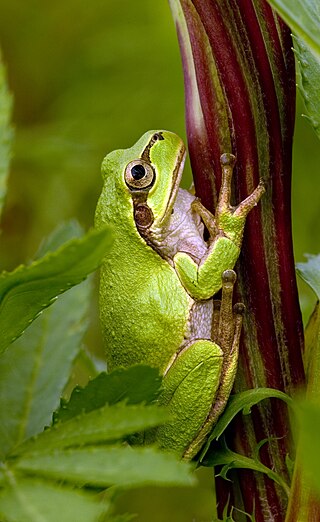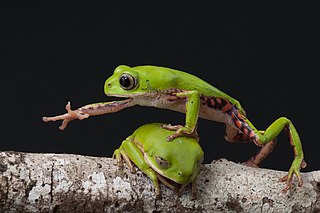
Hylidae is a wide-ranging family of frogs commonly referred to as "tree frogs and their allies". However, the hylids include a diversity of frog species, many of which do not live in trees, but are terrestrial or semiaquatic.

Agalychnis callidryas, commonly known as the red-eyed tree frog or red-eyed leaf frog, is a species of frog in the subfamily Phyllomedusinae. It is one of the most recognizable frogs. It is native to forests from Central America to north-western South America. This species is known for its bright coloration, namely its vibrant green body with blue and yellow stripes on the side. It has a white underside, brightly red and orange colored feet, and is named after its distinctive bright red eyes. One particular and special feature of the frogs coloration is its exceptional high reflectance in the near-infrared.

The American green tree frog is a common arboreal species of New World tree frog belonging to the family Hylidae. This nocturnal insectivore is moderately sized and has a bright green to reddish-brown coloration. Commonly found in the central and southeastern United States, the frog lives in open canopy forests with permanent water sources and abundant vegetation. The American green tree frog is strictly aquatic during the hibernating and mating seasons. When defending its territory, the frog either emits aggressive call signals or resolves to grapple with intruders, seldom leading to injury or death. To avoid predation, the frog will leap into the water or jump into the treetops.

Hyla japonica, commonly known as the Japanese tree frog, is a species of anuran native to Japan, China, and Korea. H. japonica is unique in its ability to withstand extreme cold, with some individuals showing cold resistance at temperatures as low as −30 °C for up to 120 days. H. japonica are not currently facing any notable risk of extinction and are classified by the IUCN as a species of "least concern". Notably, H. japonica have been sent to space in a study that explored the effect of microgravity on H. japonica. Hyla japonica is synonymous with Dryophytes japonicus.

Fletcher's frog, commonly known as the sandpaper frog or black-soled frog, is a species of nocturnal, terrestrial frog native to eastern Australia. It is primarily found in wet sclerophyll forests along mountain ranges and the coast.

The squirrel tree frog is a small species of tree frog found in the southeastern United States, from Texas to Virginia. This is an introduced species in the Bahamas. Squirrel tree frogs are small frogs, about 1.5 inches in length as adults. There are several color variations, but most commonly they are green and look very much like the American green tree frog. They can also be varying shades of yellow or brown, sometimes with white or brown blotching.

Phyllomedusa bicolor, the giant leaf frog, bicolor tree-frog, giant monkey frog, or waxy-monkey treefrog, is a species of leaf frog. It can be found in the Amazon basin of Brazil, Colombia (Amazonas), Bolivia, and Peru, and can also be found in the Guianan Region of Venezuela and the Guianas, and in Cerrado of the state of Maranhão in Brazil.

Phyllomedusa sauvagii, the waxy monkey leaf frog or waxy monkey tree frog, is a species of frog in the subfamily Phyllomedusinae. It is native to South America, where it occurs in Argentina, Bolivia, Paraguay and Brazil. This species is arboreal, living in the vegetation of the Gran Chaco.

Hyalinobatrachium fleischmanni, also known as Fleischmann's glass frog or the northern glass frog, is a species of frog in the family Centrolenidae. It is found in the tropical Americas from southern Mexico to Ecuador. Specifically, these frogs occur in Mexico, Belize, Costa Rica, El Salvador, Guatemala, Honduras, Nicaragua, and Panama, Colombia, and Ecuador. It has often been confused with related species, and the exact distribution depends on the source. This frog tends to have green skin, pale yellowish spots, yellow fingertips and translucent skin covering its stomach.

Dendropsophus branneri is a small hylid tree frog endemic to the Atlantic Forest region of Brazil. It feeds mainly on arthropods and is preyed upon by various invertebrates and vertebrates. Although currently classified by the IUCN Redlist as "least concern", D. branneri suffers rapid habitat loss due to residential development, agriculture, logging, and clearing for pastureland. Male D. branneri are noted for their fighting call, which differs significantly in frequency, duration, and pulses per call compared to their mate advertisement call. Males are also noted for their willingness to escalate physical altercations against other males, which includes kicking, pushing, and wrestling their opponent into non-dominant positions. Unlike most other frog species, D. branneri can breed in both temporary and permanent pools allowing it to inhabit a wide variety of habitats leading to its wide distribution.

Dendropsophus ebraccatus, also known as the hourglass treefrog, referring to the golden-brown hourglass shape seen surrounded by skin yellow on its back. Their underbellies are yellow. Their arms and lower legs usually display bold patterns while their upper legs or thighs are light yellow giving them the appearance of wearing no pants. The species name "ebraccata" translates to "without trousers" in Latin.

Dendropsophus minutus is a species of frog in the family Hylidae. It is found in Argentina, Bolivia, Brazil, Colombia, Ecuador, French Guiana, Guyana, Paraguay, Peru, Suriname, Trinidad and Tobago, Uruguay, and Venezuela. In Spanish it is known as ranita amarilla común.

Dendropsophus phlebodes, the San Carlos treefrog or San Carlos dwarf treefrog, is a species of frog in the family Hylidae. It is found in western Colombia, Costa Rica, Nicaragua and Panama. Its natural habitats are tropical moist lowland forests, but it may also occur in disturbed habitats. It is threatened by habitat loss.

Rosenberg's treefrog, also known as Rosenberg's gladiator frog or Rosenberg's gladiator treefrog, is a species of frog in the family of tree frogs (Hylidae) and genus of gladiator frogs (Boana) found in Costa Rica, Panama, Colombia, Trinidad and Tobago and north-western Ecuador. Its scientific name is a testimony to Mr. W. F. H. Rosenberg who collected the type series, and its common name refers to the aggressiveness of males of the species.

Pithecopus rohdei, also known as Rohde's leaf frog, Rohde's frog, and Mertens' leaf frog, is a species of frog in the subfamily Phyllomedusinae. The species was previously placed in the genus Phyllomedusa. The species is endemic to southeastern Brazil and occurs at elevations up to 1000 meters above sea level.

Phyllomedusa trinitatis is a species of frog in the subfamily Phyllomedusinae. It is found in Venezuela and the island of Trinidad.

The Panama cross-banded tree frog or pug-nosed tree frog is a species of frog in the family Hylidae found in the humid Pacific lowlands of southwestern Costa Rica to eastern Panama and in the Caribbean lowlands of Panama and northern Colombia. Males of the species utilize synchronous calling to hide their position from predators. Females create basins during amplexus and deposit fertilized eggs onto the surface of the water.

Lithodytes is a genus of frogs in the family of Leptodactylidae. It is monotypic, being represented by the single species, Lithodytes lineatus, also commonly known as the gold-striped frog or painted antnest frog. It is found in tropical South America where it lives in humid forests among the leaf litter. These frogs build foam nests at the edge of temporary pools, and the tadpoles develop within these. The frogs also associate with certain leafcutter ants and breed inside their nests without being attacked by the ants.

Stefania evansi is a species of frog in the family Hemiphractidae. Stefania evansi is, along with other closely related frogs, known for its unusual reproductive mode where females carry the eggs and juveniles on their back. It is sometimes known under common names Groete Creek carrying frog, Groete Creek treefrog, or Evans' stefania. These names refer to its type locality, Groete Creek in the region Essequibo Islands-West Demerara, Guyana, where the holotype was collected by one Dr. R. Evans.






















